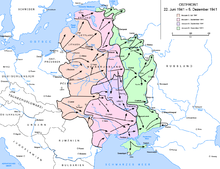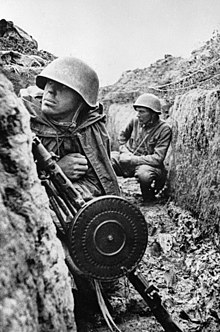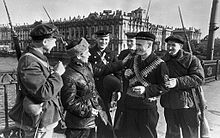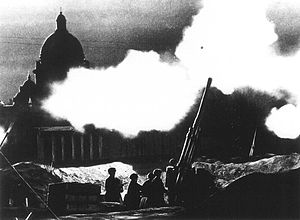Siege of Leningrad
Leningrad Blockade
Part of: World War II, War against the Soviet Union 1941-1945
Defensive fire near St. Isaac's Cathedral during an air raid on Leningrad, 1941.
Significant military operations during the German-Soviet War
1941: Białystok-Minsk - Dubno-Luzk-Rivne - Smolensk - Uman - Kiev - Odessa - Leningrad Blockade - Vyazma-Bryansk - Kharkov - Rostov - Moscow - Tula1942
: Rzhev - Kharkov - Enterprise Blue - Enterprise Brunswick - Enterprise Edelweiss - Stalingrad - Operation Mars1943
: Voronezh-Kharkov - Operation Iskra - North Caucasus - Kharkov - Enterprise Citadel - Oryol - Donets-Mius - Donbass - Belgorod-Kharkov - Smolensk - Dnepr1944
: Dnepr-Carpathians - Leningrad-Novgorod - Crimea - Vyborg-Petrosavodsk - Operation Bagration - Lviv-Sandomierz - Yassy-Kishinev - Belgrade - Petsamo-Kirkenes - Baltic States - Carpathians - Hungary1945
: Courland - Vistula-Oder - East Prussia - Western Carpathians - Lower Silesia - Eastern Pomerania - Lake Balaton - Upper Silesia - Vienna - Oder - Berlin - Prague.
Leningrad Blockade (Russian блокада Ленинграда blokada Leningrada) refers to the siege of Leningrad by the German Army Group North and Spanish troops (Blue Division) during World War II. It lasted from 8 September 1941 to 27 January 1944, or about 28 months.
It is estimated that about 1.1 million civilian residents of the city lost their lives as a result of the blockade. Most of these victims starved to death. The enclosure of the city by German troops with the aim of systematically starving the population of Leningrad is considered one of the most blatant war crimes committed by the German Wehrmacht during the war against the Soviet Union.
On the 75th anniversary of the end of the blockade on 27 January 2019, the German Federal Government announced through the Federal Foreign Office that it would support the still-living victims of the blockade as well as projects for German-Russian understanding with around twelve million euro. The projects are to be implemented together with the Gesellschaft für Internationale Zusammenarbeit (GIZ).

Course of the front around Leningrad (May 1942 to January 1943)
German Offensive
After the forces of the Soviet Northwest Front (8th, 11th, and 27th Armies) were defeated by the Wehrmacht in the Battle of the Baltic at the end of June 1941, the Wehrmacht's Panzer Group 4, advancing in the lead, forced its way to Pskov and Ostrov; both cities were taken by 10 July. Meanwhile, the slower-following German 18th Army pushed the Soviet 8th Army back into Estonia via Riga (which fell on 29 June) and was on the Gulf of Finland at Kunda on 7 August. Meanwhile, the XXXXII Army Corps, attached to Army High Command 18 from 22 July, fought in the western part of Estonia, capturing Tallinn by 28 August and the major Baltic islands by mid-October. In mid-August, the 18th Army attacked Narwa, and the XXVI Army Corps reached the Luga section near Kingissepp on 17 August. The German 18th Army advanced on Leningrad from the southwest, while Panzer Group 4 and the 16th Army advanced north and south of Lake Ilmen to cut Leningrad off from the east and link up with Finnish forces on the eastern shore of Lake Ladoga. Artillery bombardment of the city began on September 4. On September 8, the Wehrmacht captured Schlüsselburg on the shore of Lake Ladoga and severed the land link to Leningrad.

The Eastern Front at the Beginning of the Siege of Leningrad

Soviet machine gunners in a trench outside Leningrad, September 1941
Soviet Defense
On June 27, 1941, the Leningrad Soviet decided to mobilize thousands of people to build fortifications. Several defensive positions were built. One of these defensive positions ran from the mouth of the Luga River to the Neva River via Chudovo, Gatchina, Urizk, Pulkovo. A second ran from Peterhof to Gattschina, Pulkowo, Kolpino and Koltuschi. A third position against the Finns was built in the northern suburbs of Leningrad. In all, 190 kilometers of beam barriers, 635 kilometers of barbed wire entanglements, 700 kilometers of armored trenches, 5,000 earth-and-wood emplacements and reinforced concrete artillery emplacements, and 25,000 kilometers of civilian trenches were constructed. A gun from the cruiser Aurora was installed on the Pulkovsky Heights south of Leningrad.
The supreme chairmanship over the "Commission for the Defense of Leningrad" was transferred to Political Commissar Andrei Zhdanov on July 1, 1941, who also served as a member of the Leningrad Front War Council. Party cadres Alexei Kuznetsov and Pyotr Popkov were responsible for organizing civilian life and distributing food within the city. They ordered the construction of temporary access roads to the western shore of Lake Ladoga.
On September 14, at Stalin's behest, Army General Georgi Zhukov had assumed the supreme command of the Leningrad Front, which was subordinated to the 8th, 23rd, 42nd and 55th Armies. However, as early as October 10, 1941, Zhukov was replaced by General Ivan Fedjuninsky, and the latter by Lieutenant General Mikhail Khosin on October 27. Zhukov was entrusted with the decisive defense of Moscow, where strong German tank forces were also withdrawn from the Leningrad area.

Defenders of Leningrad (marines and workers of the Kirov plant) in April 1942
Questions and Answers
Q: What was the siege of Leningrad?
A: The siege of Leningrad was a siege during World War II that lasted for 872 days.
Q: When did the siege of Leningrad start?
A: The siege of Leningrad started on September 8, 1941.
Q: When was the city's last road severed?
A: The city's last road was severed on September 8, 1941.
Q: When did the Soviet Union forces manage to open a narrow path to the city?
A: The Soviet Union forces managed to open a narrow path to the city on January 18, 1943.
Q: When was the siege of Leningrad stopped?
A: The siege of Leningrad was stopped on January 27, 1944.
Q: What is the siege of Leningrad known for?
A: The siege of Leningrad is known as one of the most destructive sieges ever to happen, with over 1 million innocent people killed.
Q: What did the residents of Leningrad have to eat during the siege?
A: The residents of Leningrad had to eat things such as cats, sawdust, horses, wallpaper paste, human flesh (e.g. babies), and anything that could be salvaged and was edible because of the lack of food due to the siege.
Search within the encyclopedia
